Growing strawberries in a greenhouse
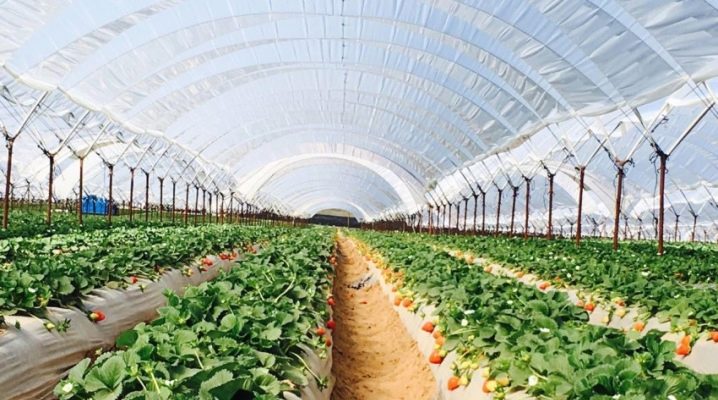
Just two decades ago, strawberry lovers could feast on juicy berries exclusively in the summer. Even in large chain stores it was quite difficult to find it at other times of the year, and it cost quite a lot of money. Exceptionally large greenhouse enterprises, which had the necessary equipment, grew strawberries all year round. Fortunately, today even the owner of a small summer cottage, with certain investments, can afford to organize a year-round collection of his favorite delicacy by building a small greenhouse. Such winter gardening is carried out both as a hobby and developing their own business selling fresh fragrant berries to shops or private customers.
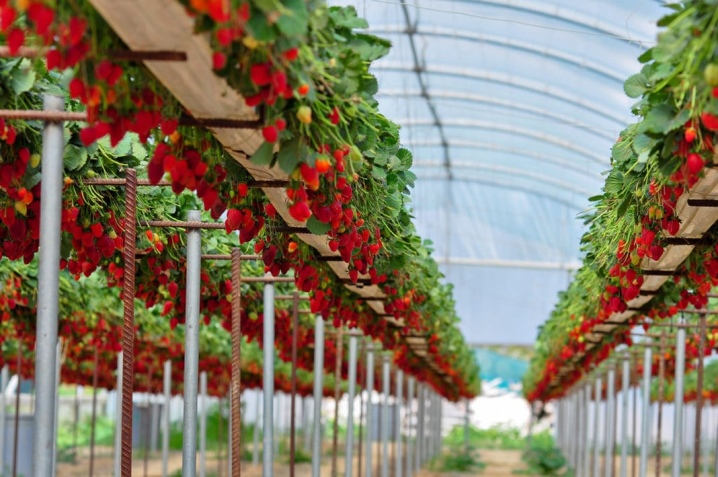
Advantages and disadvantages
For those who prefer to grow strawberries exclusively for their own needs, there is no great need to harvest berries several times a year.... In modern freezers, products, even those laid in early summer, will perfectly hold out until winter, and such a chamber costs less than organizing a special greenhouse.
Those who plan to develop their own strawberry business should carefully weigh all the pros and cons of such cultivation.

Of the minuses, two main ones can be distinguished.
-
Large start-up investments... The purchase of the necessary materials and equipment, the purchase of seedlings and, possibly, soil - all this will require considerable financial investments. In addition, the larger the area of the site, the more likely hired personnel will be needed, since one owner cannot cope with large volumes of work.
-
The need to organize heating of the greenhouse... Unfortunately, in the conditions of our winter, it is impossible to grow berries without additional heating even in the highest quality and most expensive greenhouse. Therefore, an area where it is impossible to organize the supply of heat will not work.
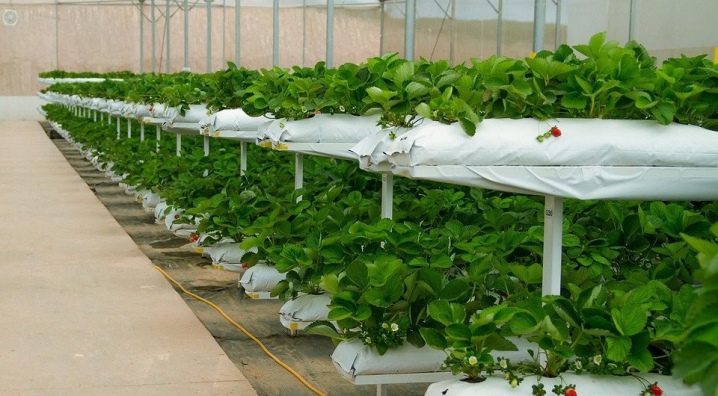
Despite the fact that the organization is greenhouses require a lot of money, its advantages still outweigh.
-
Does not depend on the season. You can pick berries from one bush not only in summer, but several times a year. On average, 1-2 harvests are obtained per season.
-
Climate and environment independent. The yield of greenhouse strawberries does not depend on the amount of precipitation or average temperatures of the climatic zone, but solely on the organization of the greenhouse itself. In a well-equipped greenhouse, strawberries can be planted even in the northern regions. However, the lower the average temperatures, the more heating and maintenance the plants will require.
-
Ease of maintenance. Compared to open beds, greenhouse berries are much easier to care for. The soil is less overgrown with weeds, and the humidity is easy to control with a drip irrigation system.
-
Payback... Even the largest investments in the berry business will pay off in 1-3 seasons, because supermarket chains are eager to purchase such a product for subsequent sale.
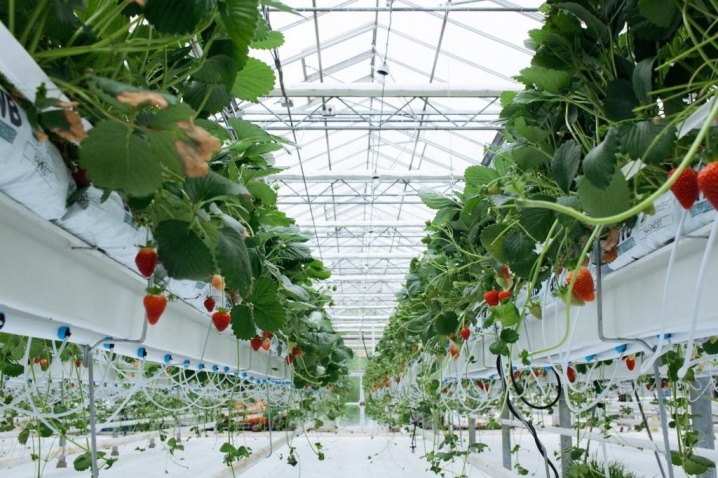
Suitable varieties
Not all garden strawberries that are grown for your own consumption are suitable for running a business. If for homemade jams and preserves, the appearance of the berries is secondary in relation to their taste, then for sale this, on the contrary, is of the main importance. Therefore, strawberries should be beautiful first of all, with large, even berries of the same size. They must be easy to transport and have a good keeping quality in order to maintain their appearance before being sold.
Of course, besides beauty, taste is also important. The juicier and sweeter the berry, the more willingly they buy it for eating or preparing various dishes.
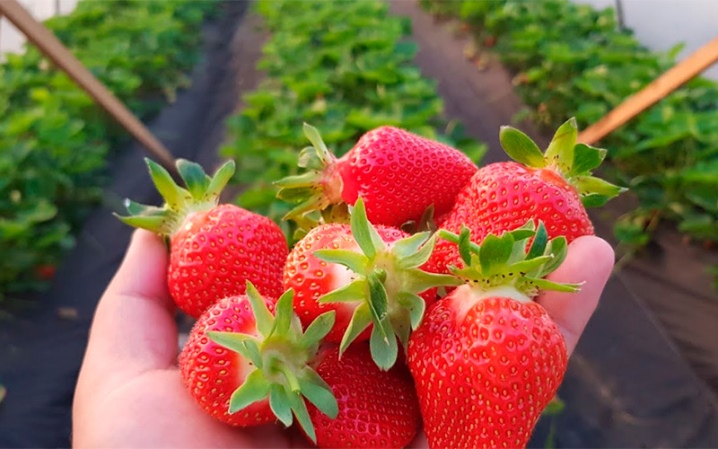
And, finally, no less important features of suitable varieties of berries are their self-pollination, high productivity and belonging to the neutral day variety. Strawberries should be early, remontant and not require pollination insects to bear fruit every few weeks.
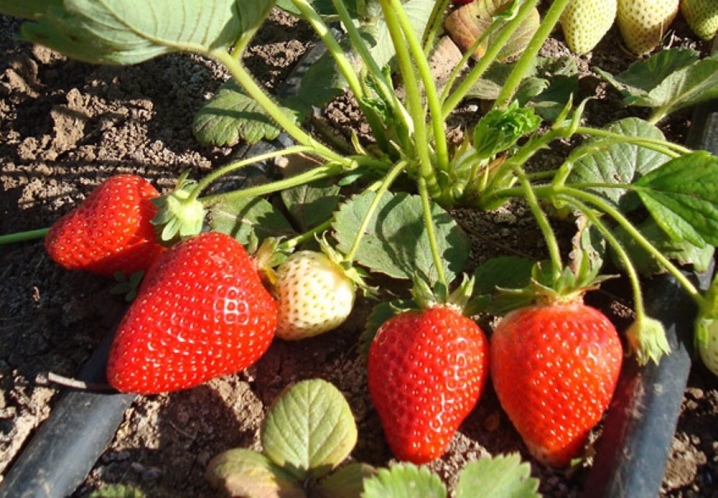
Experienced businessmen and gardeners have long identified the most suitable among the suitable varieties of strawberries through long experiments. These include:
-
Crown;
-
Gigantella;
-
Honey;
-
Elsanta;
-
Queen Elizabeth;
-
Victoria;
-
Brighton;
-
Albion;
-
San Andreas;
-
Sonata.
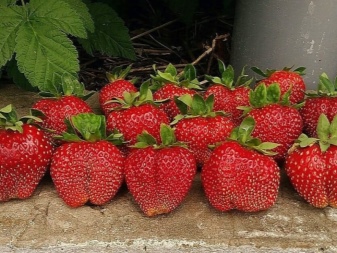
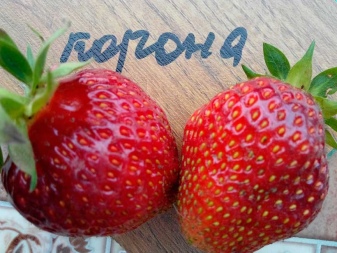
Necessary equipment
The first and most expensive stage of growing your berries Is the construction and equipment of a special greenhouse. There are three most common materials from which such houses are made in the garden.
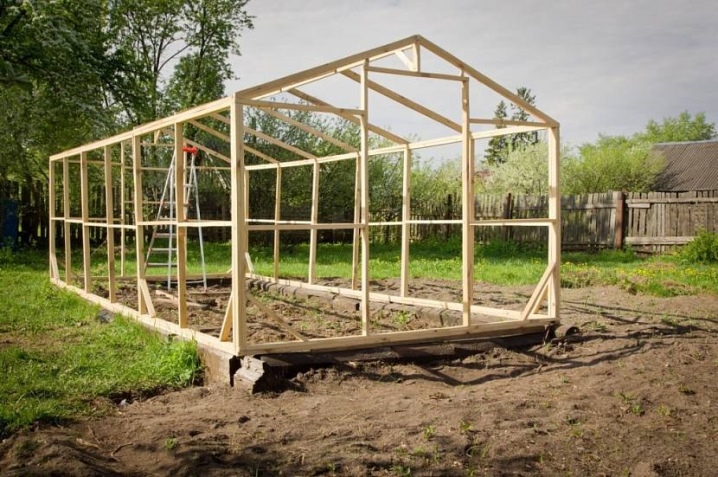
Polycarbonate
The best choice for building a greenhouse is polycarbonate.
It is cheap, reliable and can withstand heavy loads and temperature changes.
If you use it together with a special wooden or metal frame, then such a greenhouse will not be afraid of either wind or snow piles.
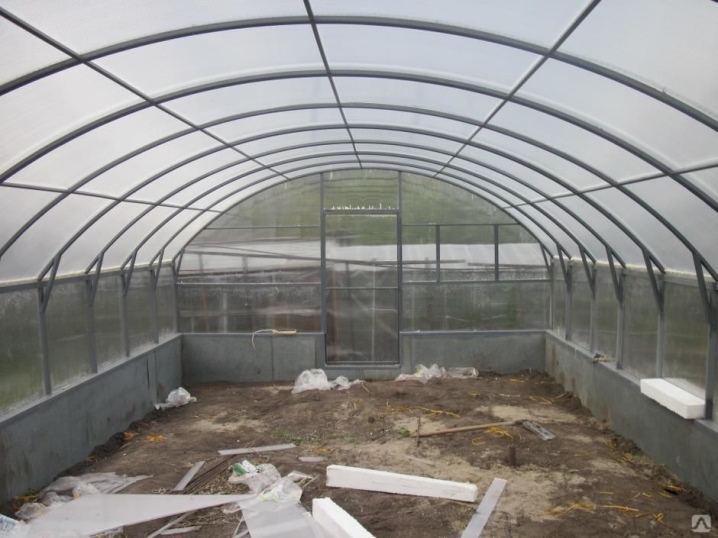
Glass
Glass is considered a slightly less common option for building a greenhouse, since it is more expensive and at the same time more fragile. In regions where the average annual precipitation is not too high, and the glass roof will not be broken by snow or hail, they are chosen for the ease of maintaining a microclimate.

Film
The third version of the material is suitable only for the southern regions, where winter does not frighten with frost or snow.
The thermal insulation properties of the film are not too high, and such a greenhouse is destroyed much faster.
But its low price can compensate for all these inconveniences if the climatic conditions of the region make it possible to insulate unheated greenhouses.
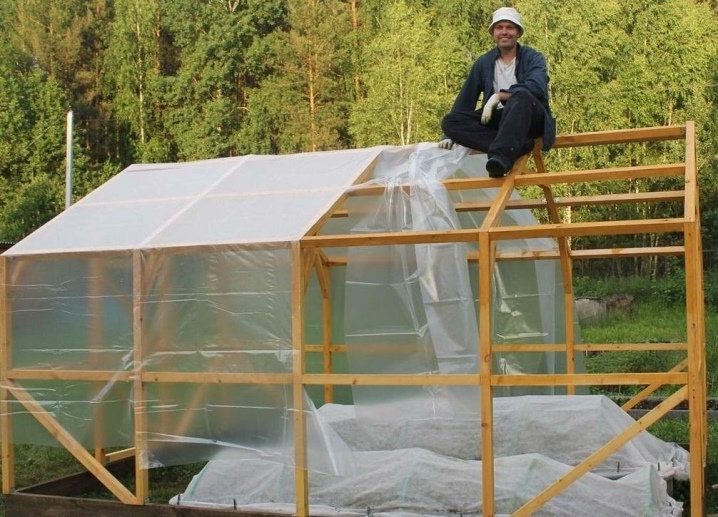
In addition to the greenhouse itself, you will also need a lot of equipment.
-
Backlight in the form of various lamps of fluorescent and ultraviolet light.
-
Irrigation system. It is best to use drip.
-
Heating system, maintaining uniform heating throughout the entire height of the greenhouse and maintaining the desired temperature.
-
Various sensors: thermometers, hygrometers and others.
-
Furniture in the form of various racks and boxes for multi-level planting.
-
Little things in the form of gardening gloves, hoes, watering cans and more.
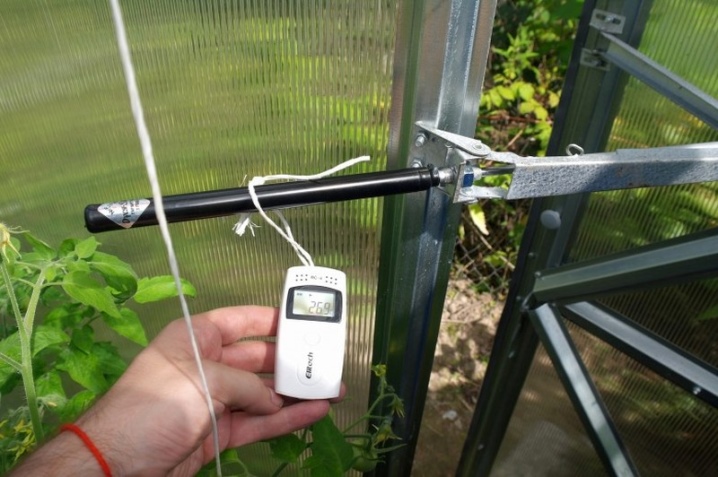
The ways
With the choice of the right greenhouse, work in the country is just beginning. You can also plant a berry inside the fenced area in different ways. There are several main ways, and every year gardeners and gardeners come up with something new. Both the yield and the complexity of caring for the crop depend on the choice of the method of placing bushes with strawberries.
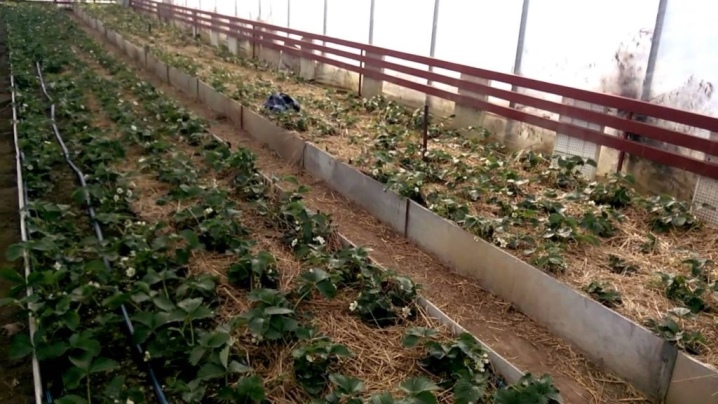
In the ground
The most classic and familiar way for all is the direct planting of plants in the ground. You can make small beds in advance, or you can plant the selected site in a checkerboard pattern or by a two-line method. The gap between two seedlings should be at least 30 cm, and between the beds, passages of at least 1 m are needed.
The soil can be sprinkled with mulch to slow down the growth of weeds. And also spunbond is used for this purpose.
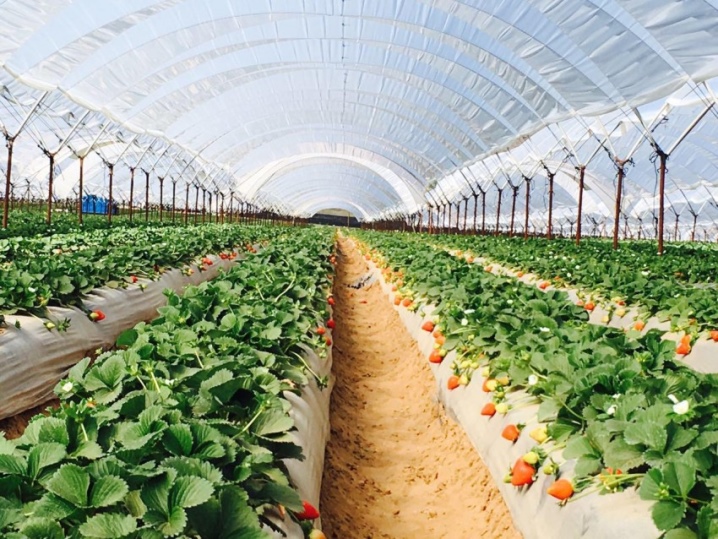
The advantages of this method are minimal costs and ease of maintenance of such beds. There is no need to buy additional furniture or build complex suspended structures. However, the main disadvantage in this case will be the irrational use of the greenhouse area, the upper part of which will remain unused.

Dutch technology
This method is by far the most popular in most countries.... It can be used both in greenhouses and outdoors. The bottom line is that the ground is covered with a large piece of black film, in which holes are cut at a distance of 30-40 cm from each other. Young strawberry seedlings are placed in these holes for the entire fruiting period.Seating scheme - chess.
This method allows the berries to receive the maximum amount of heat and light, which significantly reduces the ripening period of the fruit. The berries do not come into contact with the ground, and therefore do not need special cleaning before being sold.
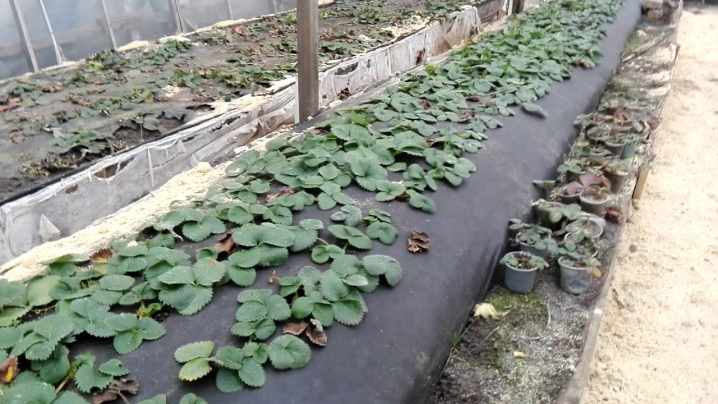
In addition, the black color of the film creates the so-called greenhouse effect on the soil surface, which prevents moisture evaporation and reduces the frequency of watering.
Of the disadvantages of this method, it should be noted the need to create a separate bed for growing seedlings. This is due to the fact that the material that has given the harvest is dug up, and new seedlings are planted in its place.
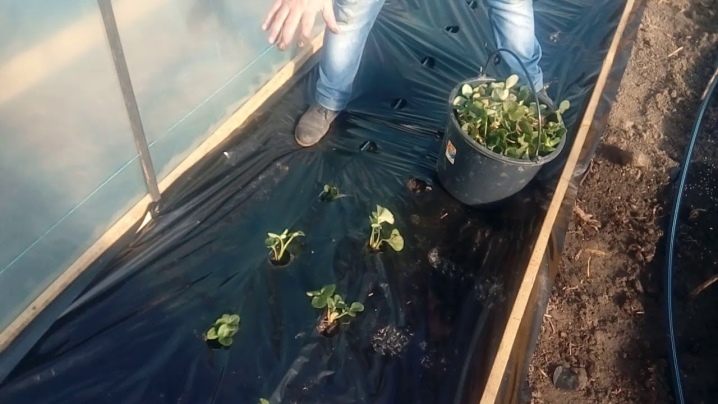
In horizontal PVC pipes
Another fairly common agricultural technique for planting strawberries is the use of wide and narrow construction pipes. The diameter of the wide ones varies from 10 to 15 cm, and of the thin ones - from 20 to 30 mm. Holes for seedlings are cut out in them. Large pipes with sawn holes are laid horizontally, and gravel or expanded clay is poured onto the bottom to add stability, and thin pipes are allowed inside, through which water will flow.
Holes are also cut in thin tubes through which moisture will enter the system.
A nutritious substrate is poured into the resulting structure, plugs are placed on the edges of a wide pipe, and a narrow one is attached to a water source. Berry bushes are planted in the substrate. One seedling should have about 3-5 liters of nutrient soil.
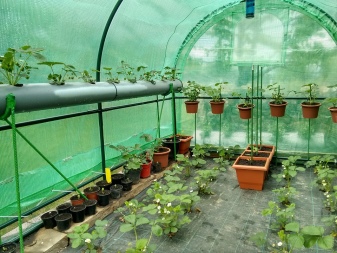
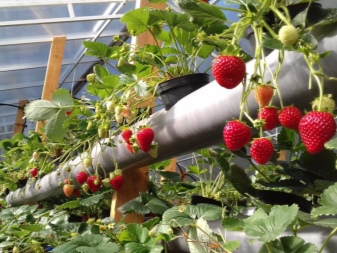
In pots and containers
The least popular, but at the same time, the most rational way of planting strawberries is considered to be planting in separate pots, boxes, and even just separate packages. This allows you to use not only the entire floor area of the greenhouse, but also to plant it vertically on several levels. For 1 sq. m of area in this way, you can place from 20 to 50 bushes of a plant.
The diameter of one container should not be less than 20 cm, and it is best to use durable materials: wood, concrete, plastic.
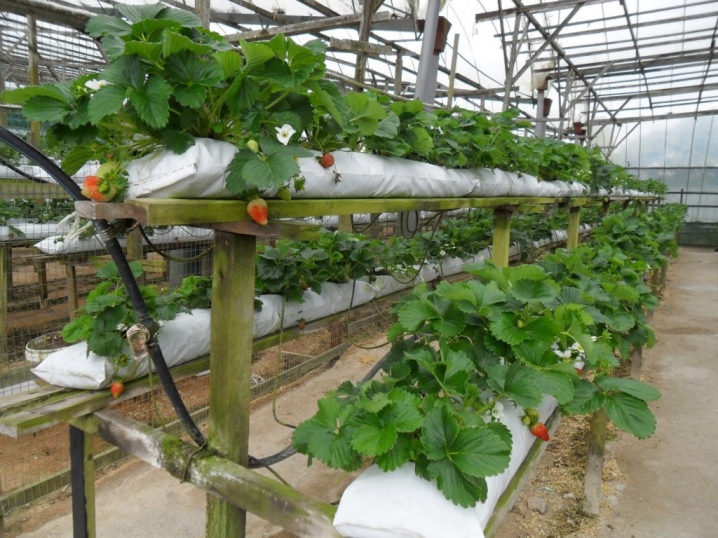
The planting itself is not much different from planting indoor flowers.
-
Place a drainage layer on the bottom.
-
Then lay out a layer of damp substrate.
-
Make a small indentation and place the seedling.
-
Gently sprinkle the roots and tamp the soil.
-
Drizzle with warm water.
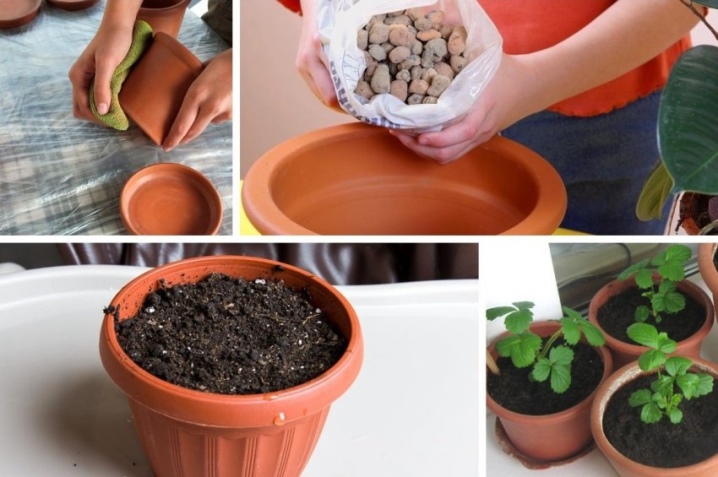
This method is not suitable for varieties of berries with wide roots or high stems. Light-loving strawberry species should also not be grown at several levels, or you need to provide additional lighting for the lower tiers.
You can grow berries in separate pots without using land at all. This method, which is gradually gaining popularity, is called "hydroponics". Instead of soil, a special artificial composition with fertilizers is poured into pots or bags, which the strawberry bush feeds on during the growth and ripening of berries.
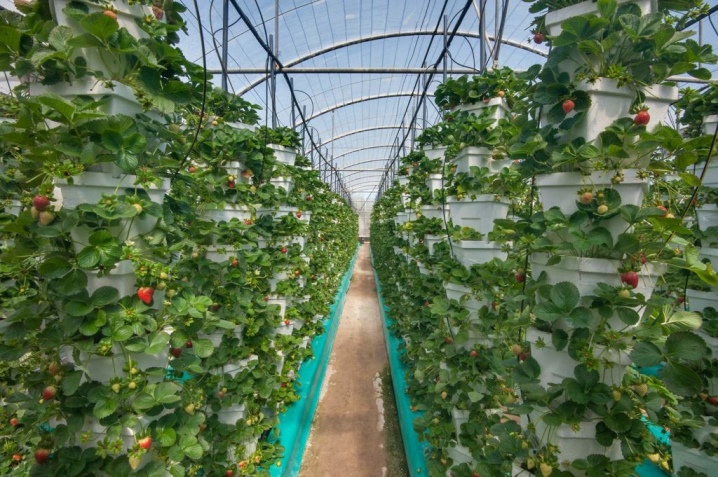
Landing features
After the greenhouse and additional equipment are ready, the preparation phase begins.
The soil
First of all, a whole year before planting, you need to prepare the soil. Soil made from rye, wheat, or other cereals would be the ideal choice. And also peat soil or purchased special soil is suitable.
The main thing is that tomatoes or cucumbers do not grow on it before.
Additional humus, lime and baking powder in the form of perlite, mineral wool or various substrates are introduced into the ground. Before laying out and planting, the soil is abundantly moistened.
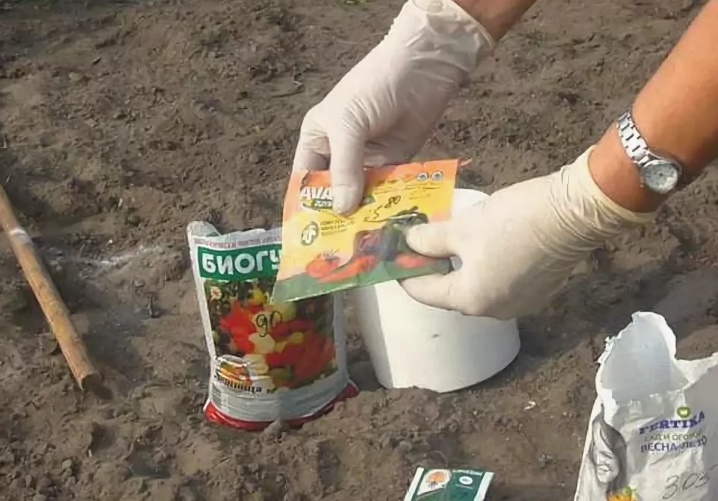
Seedling
While the soil hibernates in an empty greenhouse, it's time to choose seedlings, the variety of which was determined in advance. Those who grow strawberries for the first time will have to buy seedlings from friends or suppliers. In order for the purchased product to be of high quality, you should know the basic selection criteria.
-
The leaves should be free of spots, wrinkles and other defects. The color of healthy seedlings is rich and even.
-
Every bush should have at least three sheets.
-
The root neck should be thicker than 5 mm and free from stains and rot. The length of the roots themselves is not less than 70 mm, without damage or defects.
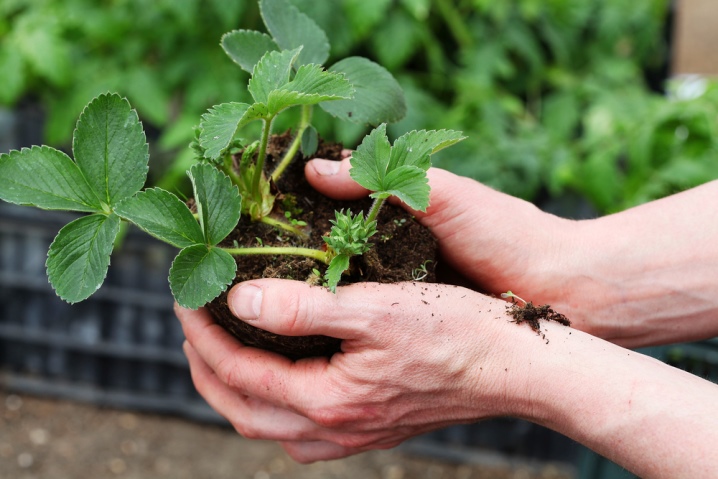
The best option is to purchase special seedlings, which are germinated from mother bushes and additionally "heal"... If the berries grew before that on the site, you can collect the seeds and germinate them yourself.
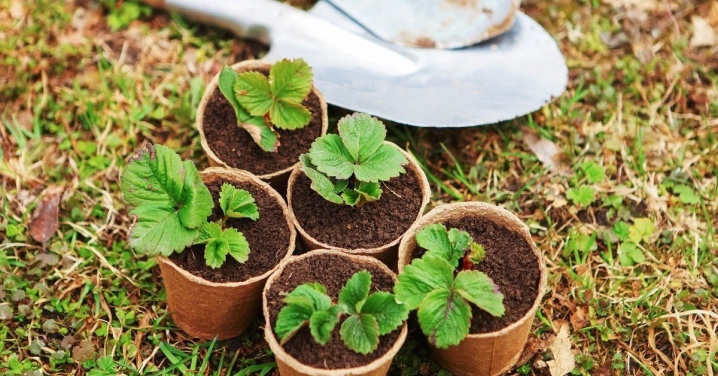
Landing
Young strawberry rosettes are planted in the greenhouse most often in the fall. But doing this in October-November is not at all necessary, any month will do. The basic rule for landing is that the air temperature should not be higher than +15 degrees, and the humidity should be about 85%. The seedlings will have to be supplemented with additional light if the daylight hours are less than 8 hours. Forced ventilation of the greenhouse is carried out once a day, and a special feeding is applied every two weeks.
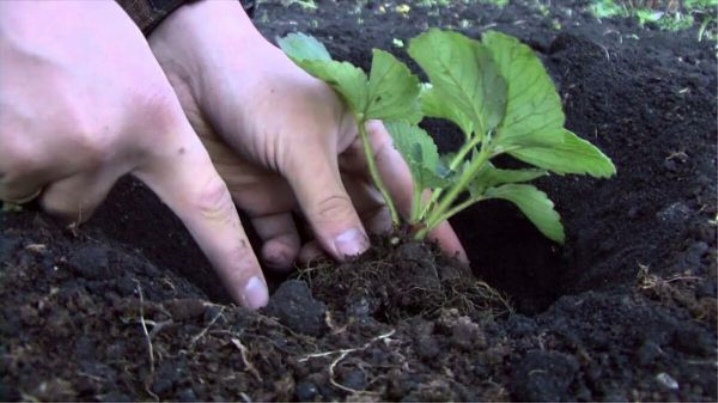
The nuances of care
A month after planting, when flowering begins at the rosettes, the first inflorescences must be cut off so that the bush has time to get even stronger by the time the berries begin to grow. The temperature during this period should be at + 20 ... 24 degrees, and during the ripening of berries - not lower than +24 degrees.
Daylight hours should be at least 12 hours, and preferably 14-16. During the formation of fruits, it is better to maximize this indicator. It is worth watering a flowering plant as the soil dries up, but not more than 2 times a week. Excess moisture will quickly bring rot and fungal infections with it.
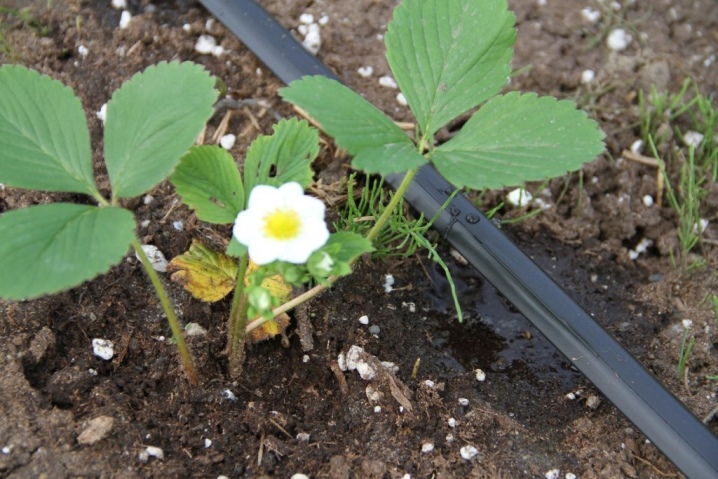
You can pollinate flowering berries with a small brush or fan, but if you choose the right variety, this will not be necessary.
This is especially convenient if you need to grow berries in winter, since in summer pollination occurs naturally - you just need to open the greenhouse door and let the insects in.
You can feed flowering and fruiting plants with potassium, ammonia and organic fertilizers. Best suited for this ammonium nitrate, potassium chloride or ordinary manure... Feeding frequency - once in two weeks.

Separately, it is worth noting the wintering conditions for strawberries in the absence of heating. Unfortunately, in the conditions of our climate, it is almost impossible to do this. Even if you insulate the walls of the structure and cover the beds with heat-insulating materials, the plants will die in severe frosts. Some summer residents solve this problem by transporting seedlings to the warmth of a residential building. If the berries are grown in separate containers or pots, this will not be difficult.
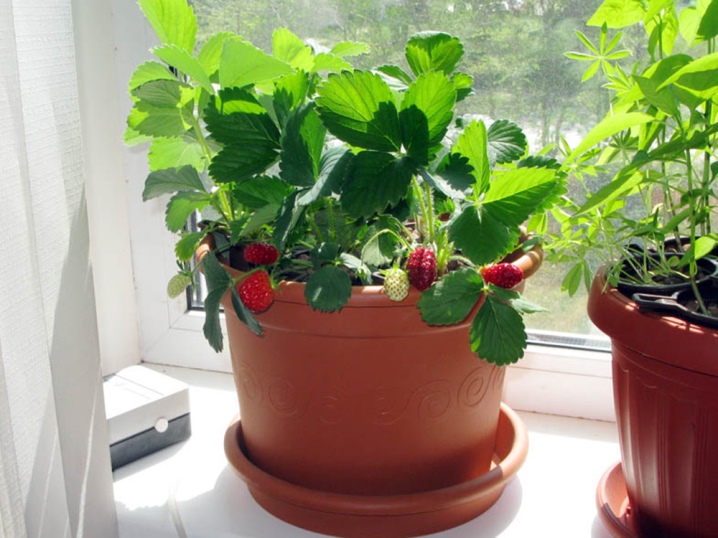
Diseases and pests
Unfortunately, juicy and sweet strawberries are loved not only by people, but also by various insects. For example, spider mites, weevils or nematodes. And the plant itself is susceptible to various diseases. In the absence of proper care or improper growing conditions, white and gray rot, ramularia, and even powdery mildew can be found in the beds.
It is quite difficult to deal with diseases or pests in the greenhouse, so it is best to prevent such situations.

This is easy to do if you follow the basic rules.
-
Plant only healthy seedlings.
-
Ventilate the greenhouse regularly, and monitor the humidity level.
-
Do not plant young outlets too close to each other.
-
Do not add excess fertilizer unless necessary.
-
Once a season, carry out preventive treatment with fungicides, introducing them into the water for irrigation.
-
Tear off diseased and damaged leaves in a timely manner and do not be afraid to sacrifice a whole plant in order to save the rest.
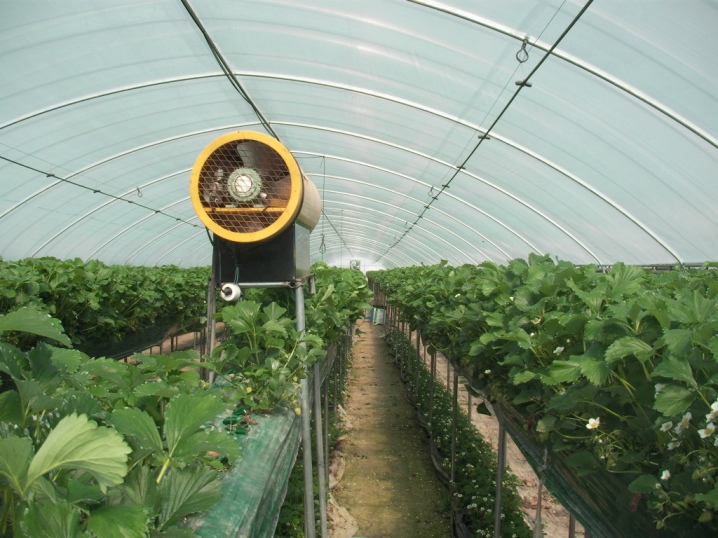
After a healthy harvest has been obtained, it must be sold or processed as soon as possible, so buyers need to be found in advance, and a book with recipes for your favorite compote and jam can be found on the far shelves of the cabinet.














The comment was sent successfully.